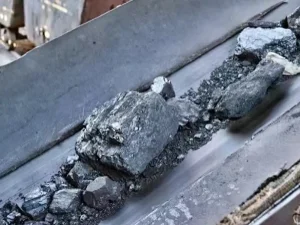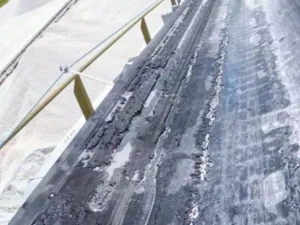Conveyor belts are the backbone of countless projects, from mining industries to airports. They facilitate transporting tons of material daily, keeping operations running smoothly. This smooth transportation can sometimes stop due to several types of conveyor belt damage. A slight misalignment can lead to serious results, such as production delays.
So, understanding the damage to the conveyor belt is crucial. By identifying the causes early, you can find a solution and enhance the belt’s lifespan. But, if you neglect those damages, you will have safety hazards and financial losses. So, do you want to avoid those costly repairs? This article is all about helping you identify damages and their solutions. So let’s get started!
Types of Conveyor Belt Damage
Every conveyor belt undergoes several minor wears, but not all those damages are the same. Some damage slows down the system; however, some lead to severe failure. So, let’s explore some common types of conveyor belt damage and find their causes and solutions.
1- Wear and Tear Damage

It is the most common type of damage to fabric conveyor belts. In this damage, you will see thin and bald spots, cracks, and worn-out edges on a belt. But what are the causes of this damage? The first and most prominent cause is the continuous use of conveyor belts.
As you know, belts face continuous friction with rollers. This friction weakness and worn out the belt corners. Moreover, When the belt carries heavy abrasive materials, they rub against the surface. This causes scratches, and sharp objects can penetrate the surface, causing gradual wear.
Solution: Use the right material for the right belt. For example, if you want to transport abrasives, use metal belts. Moreover, avoid overloading the belt and ensure that the belt is aligned correctly.
2- Impact Damage
Impact damage occurs when a heavy object falls on the conveyor belt. When dropped from a height, these heavy objects cause deep dents, holes, and punctures. This damage is usually caused by mining when rocks or stones drop from a height.
Belts often become prone to this damage when transporting sharp-edged objects such as metal and glass pieces. Lastly, when the belt is old and worn, or you load the material unevenly, it will cause impact damage.
Solution: Use an impact-resistant belt with a durable material to handle heavy forces. You should use loading chutes to control the speed and direction of falling objects. Moreover, installing shock-absorbing pads under belts is better to reduce stress.
3- Gouges and Cuts

Gouges are deep cuts or slashes on the surface of belts. Unlike normal wear, these cuts are deep and occur suddenly. For example, if a belt carries sharp glass or metal pieces, they will slice the belt and cause gouges.
It can also be caused by foreign objects like bolts or loose tools. When the belt moves, these objects are stuck between rollers and belts. As a result, pressure is induced, which tears the belt as it moves. Suppose a belt is transporting fine material such as sand. In that case, it will show apparent leakage, and you can identify the damage.
Solution: You should use a reinforced rubber belt to prevent this damage. These belts have steel cages that prevent material from being wasted. Moreover, if you inspect any gouge, apply a repair patch quickly to avoid further damage.
4- Belt Edge Damage
Belt edges play a vital role in correctly aligning the belt conveyor over the track. However, sometimes, these edges wear out, known as belt edge damage. Several types of conveyor belts undergo this issue due to various causes.
One of the most common causes of those is side friction. When a belt works continuously, it sometimes collapses against the metal part of the conveyor system. This weakens the edges and leads to tearing. Other causes involve overloading, misaligned rollers, and improper belt tracking.
Solution: Use the guide idler to keep the belt on track and adjust the tension. Moreover, urethane coatings should be applied to reduce friction and wear. If you notice minor wear, apply cold vulcanizing patches.
5- Belt Delamination

Most types of conveyor belts have multiple layers. Sometimes, those layers separate from each other or peel apart, which is known as belt delamination. This damage weakens the belt structure and reduces performance.
The main reason for belt delamination is the high temperature. When the conveyor belts work in outdoor spaces, they face temperature fluctuations. When the temperature rises, it damages the adhesive power between layers, causing them to fall apart. Moreover, excessive tension and heavy impact loads also enhance this damage.
Solution: Switch to a heat-resistant belt instead of regular belts for outdoor use. Ensure the belt is not in contact with chemicals or moisture that can weaken the adhesion. Lastly, avoid overload and inspect regular wear.
6- Heat and Chemical Damage
Heat and chemicals severely affect the structure of the belt. For example, direct contact with chemicals causes swelling and discoloration of belts. As a result, they become uneven and cannot proceed with smooth movement on rollers.
However, heat can soften the belts and cause delamination. Moreover, rapid temperature changes from hot to cold also cause belts to be brittle. These damages are standard for the belts used in cement and chemical industries.
Solution: Use belts made with Neoprene, nitrile, or PVC. These materials are chemical resistant and prevent damage. If you use the belt in extreme conditions, then I recommend you to install heat shields. These shields automatically cool the belt in case of high heat.
7- Belt Slippage
Belt slippage occurs when the pulley cannot hold the belt conveyor tightly. As a result, belts slip over it and slow down or stop entirely. This can tear the fabric of belts and cause energy waste. A common cause for this damage is oily or dirty surfaces of the pulley that cannot grip the belt. Moreover, the belt cannot hold on to the pulley if the driving motor is not strong enough. Other reasons involve the wrong pulley size and too much load.
Solution: First, adjust the tension between the pulley and belt to avoid stress. Further, enhance the friction by adding rubber to the pulley to improve its grip. Lastly, keep the belt dry from oil by using covers after use.
8- Tracking Issues (Misalignment)
Misalignment of belts refers to a situation where belts do not stay on the straight track. In simple words, belts move on one side, which causes edge wear and tear. Misalignment can also occur in other ways, such as when the belt twists or moves at an angle instead of parallel.
This damage is typical for steel cord conveyor belts. The usual reason for this misalignment is worn-out rollers. These rollers cannot guide the belt, and as a result, it drifts to the side. However, low tension and uneven load also contribute to this damage.
Solution: Examine the rollers’ wear and misalignment. If they are in the wrong position, set them right. Moreover, you should also distribute the objects evenly to prevent the belt from drifting. Lastly, ensure that the belt is tightly secured on both sides of the pulley.
9- Material Carryback
Material carryback happens when some material is left behind on the belt after unloading. This debris can accumulate on the roller, belt surface, or pulley. It can penetrate moving parts of the pulley or rollers, affecting the smooth movement of the belt.
Moreover, if those particles cling over the belt, they increase the weight and cause wear and tear. One standard cause is static electricity from some material. These materials develop natural adhesion that helps them stick to the belt.
Solution: Use air knives or rotating brushes to quickly wipe out the fine particles. Ensure that belts are made with non-stick material to avoid clinging. Lastly, I recommend using a vibrating discharge system during unloading.
10- Splice Failure
A splice is the joint where two ends of a belt conveyor meet to form a loop. This loop ensures the continuous movement of objects from one end to another. But sometimes, the splice fails and causes misalignment of the belt from the track.
This leads to splitting the belt into two parts, stopping it, and causing production delays. So, what caused the splice failure? The first reason is poor installation of splice due to loose fasteners. Moreover, if the belt is too tight, it will pull one of its ends from splicing and cause belt damage.
Solution: Depending on the belt type, use the correct splicing method. Ensure the proper installation of fasteners and regularly inspect cracks. Lastly, You should also use shock absorbers while loading heavy objects to prevent tension buildup.
Signs Your Conveyor Belt Needs Repair
Conveyor belts are crucial machinery for running several operations. Like other machines, they also get damaged and need replacement. So it is better to repair them on time than the high repair cost. But how do you know when your conveyor belt needs repair? Here are the signs!
- Over time, the belt surface shows wear due to sharp and heavy objects. Moreover, continuous use of belts also causes frayed edges. So, when you notice cracks, cuts, or weak spots on the belt, apply a repair patch instantly.
- If the belt shows frequent slippage, it may need repair. It occurs when the pulley does not grip the belt. As a result, it slips and does not move smoothly, affecting speed and efficiency.
- A fit conveyor system works without noise. But the noise of grinding, squeaking, or screeching is a sign that the belt is misaligned. When you hear such noise, apply lubricants to moving parts of belt conveyors.
- If your conveyor system consumes more energy than usual, it needs repair. This issue is caused by heavy material buildup on the belt or increased friction due to old rollers. So when you notice higher electricity bills, replace the rollers and clean the belt.
- If the belt breaks down or stops frequently, it is a serious sign that something is wrong. Not attending in a timely manner can cause severe damage and increase repair costs. So, examine all the parts, from fasteners to structure. If necessary, add lubricants to moving parts.
Conclusion
Conveyor belts are crucial elements for several industries. They are used in airports and factories to carry different objects from one place to another. However, these conveyor belts sometimes get damaged and affect the production process. The damages vary depending on the part and external factors. In this article, I have discussed some common types of damage that conveyor belts undergo.
For example, sometimes fabric belts are prone to wear and tear and leak fine materials. Moreover, some conveyor belts show impact damage due to the fall of heavy objects. All these damages should be tackled before serious hazards occur. So, I have also addressed some signs to diagnose the damage at early stages.
